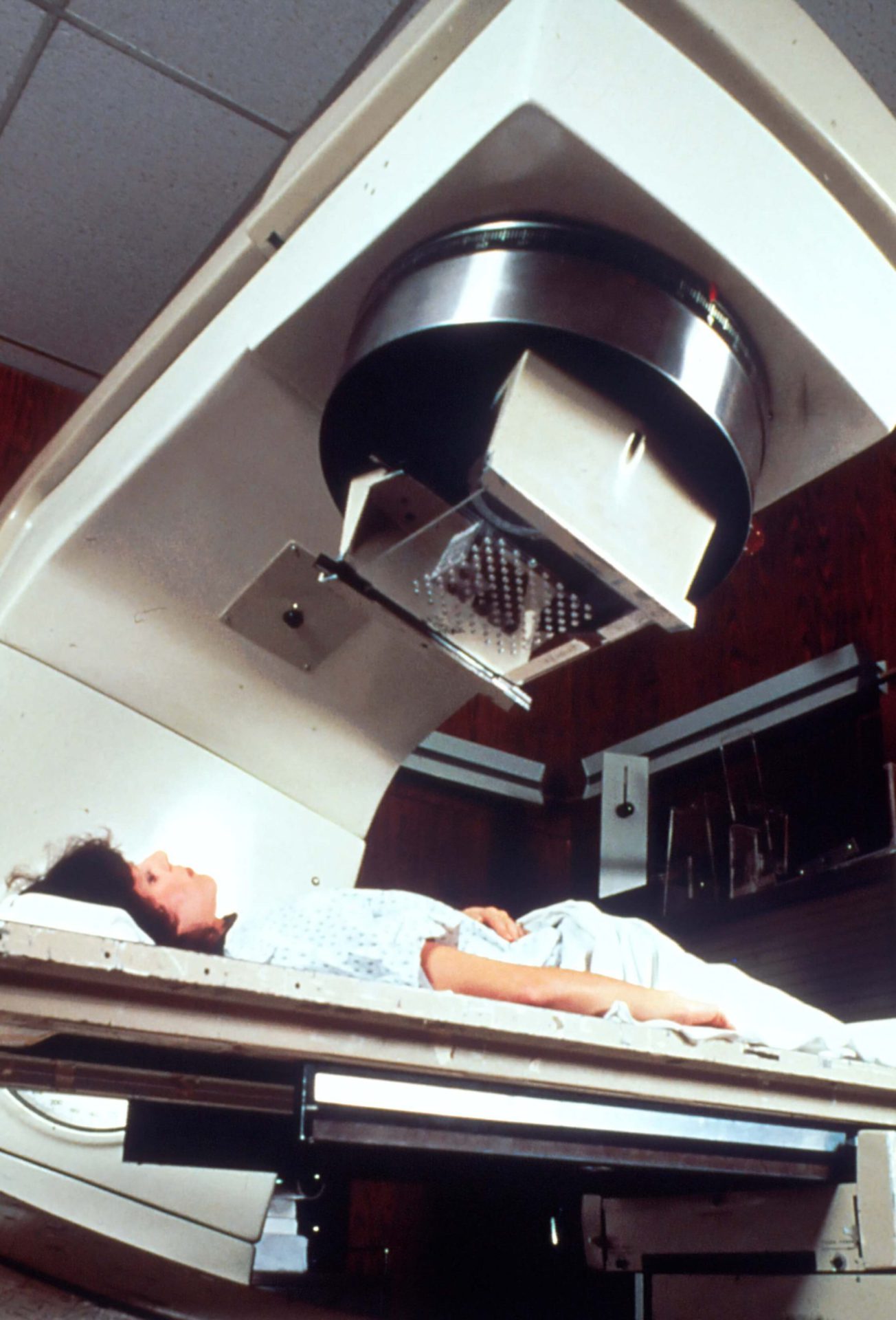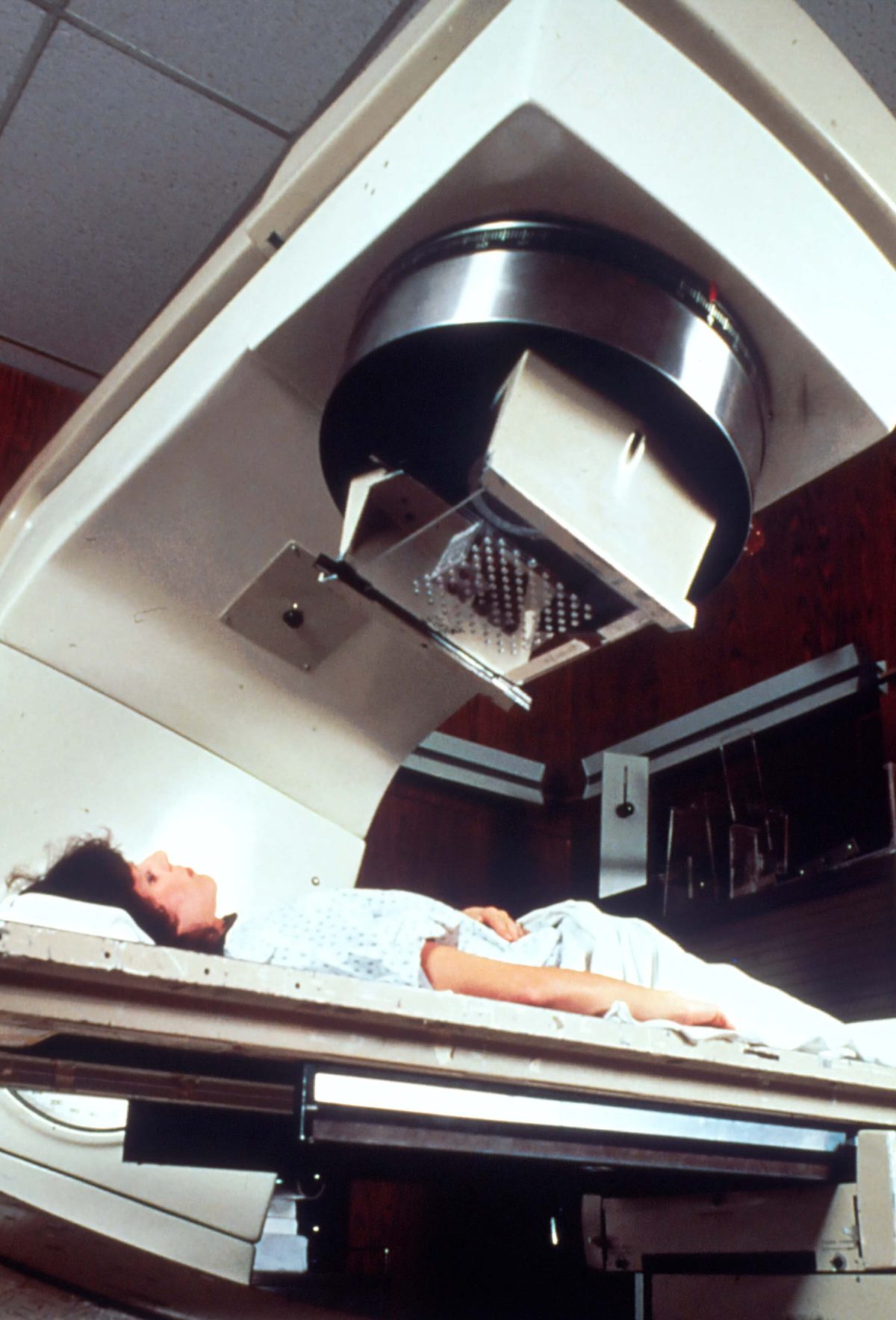Radiation Therapy FAQ and Patient Stories
Radiation therapy, also known as radiotherapy, uses high doses of radiation to destroy cancer cells and to shrink tumors.
Below, find answers to popular radiation therapy questions and experiences of radiation therapy shared by The Patient Story community.

How does radiation therapy work?
Radiation therapy in high doses destroys or slows down the growth of cancer cells through damaging the cells’ DNA. When the DNA is damaged enough, the cells will stop dividing and die. The body then breaks down and removes those damaged cells.
This process usually takes days or weeks of radiation therapy treatment before the cancer cells suffer enough damage. They continue to die for weeks, sometimes months, after the radiation therapy ends.
The actual process of radiation is pretty short. For the radiation therapy treatment, most of the appointment is usually spent positioning the body correctly.
Types of radiation therapy
Your medical team will decide what kind of radiation therapy to give you based on multiple factors, including:
- Cancer type
- Tumor size and location
- How close the tumor is to normal cells and tissue
- Other cancer treatments you’ll be undergoing
- General health history
- Age
- Other medical conditions
You can break radiation therapy down into two main types:
- External beam:
- 3-dimensional conformal radiation therapy (3D-CRT)
- Intensity-modulated radiation therapy (IMRT)
- Stereotactic body radiation therapy (SBRT) or stereotactic ablative radiation therapy (SABR)
- Internal radiation
External beam radiation therapy (EBRT)
- Commonly treated cancers: Many types
- Process: Most common type of radiation therapy. It’s delivered with machines (linear accelerators) that move around the outside of the body without touching it, which means you should not feel anything or any pain during the treatment.
- Post-therapy: You will be able to be around other people safely after the radiation therapy, as it does not make the patient radioactive.
- Types of EBRT
- 3-dimensional conformal radiation therapy (3D-CRT): 3D images created by either computed tomography (CT) or magnetic resonance imaging (MRI) provide physicians a better picture of targeting the tumor
- Intensity-modulated radiation therapy (IMRT): This is similar to the 3D method but with IMRT, the doctor can adjust levels of radiation in each beam. This is meant to help reduce side effects by targeting cancer cells and avoiding normal cells.
- Stereotactic body radiation therapy (SBRT) or stereotactic ablative radiation therapy (SABR): This treatment is thought to be more powerful in destroying cancer cells. If you get this radiation method, you should get it in five or fever treatments.
Internal radiation (Brachytherapy)
- Commonly treated cancers: Head and neck, breast, cervix, prostate, and eye
- Process: Less common type of radiation therapy, usually done outpatient. The physician will likely put small applicators or catheters directly into the treatment area to target the radiation right at the cancer. This can help limit the radiation exposure to normal cells. You will get anesthesia or sedation during the procedure, so the appointment will take some hours.
- Post-therapy:The radiation source is either solid or liquid and may emit radiation for a while.
- Types:
- Systemic therapy: Internal radiation therapy that uses a liquid source, allowing treatment to travel in the blood throughout tissues in your body to destroy cancer cells. This can be done through oral pill, IV, or injection. Body fluids like sweat, saliva, and urine will emit radiation for a while.
- Common types are radioactive iodine pill for thyroid cancer and targeted radionuclide therapy, to treat advanced prostate cancer or gastroenteropancreatic neuroendocrine tumor (GEP-NET).
- Systemic therapy: Internal radiation therapy that uses a liquid source, allowing treatment to travel in the blood throughout tissues in your body to destroy cancer cells. This can be done through oral pill, IV, or injection. Body fluids like sweat, saliva, and urine will emit radiation for a while.
How does radiation work alongside other treatments?
Radiation therapy is sometimes given alone, but mor often than not, there will be other treatments given before, during, or after the radiation.
- Radiation before surgery: Radiation can shrink the size of the tumors and cancer to improve the chances of success for surgical removal.
- Radiation during surgery: Known as “intraoperative radiation,” this radiation is applied directly to the cancer without having to go through the skin.
- Radiation after surgery: To destroy any cancer cells that might remain.
Hear from a radiation oncologist

Hear from radiation oncologist, Dr. Kenneth Biehl.
Radiation therapy stories and experiences
Here are different experiences with radiation therapy, as told by our TPS community members.
External beam radiation therapy (EBRT)
Niccole B., Stomach Cancer, Stage 4 (Metastatic)
Symptoms: Stomach pain after having alcoholic drinks, eating less, slight weight loss, acid reflux, vomiting, getting full fast
Treatments: Chemotherapy (hyperthermic intraperitoneal chemotherapy or HIPEC, open HIPEC with cytoreductive surgery), surgeries (partial gastrectomy, cholecystectomy, splenectomy, partial colectomy, partial hepatectomy), radiation therapy (targeted radiation therapy), immunotherapy, targeted therapy (PARP inhibitor)
...
Valerie V., Thyroid Cancer (Papillary Thyroid Carcinoma), Stage 4 (Metastatic)
Warning Signs: Bruising, extreme fatigue, cold intolerance, weight loss
Treatments: Surgeries (total thyroidectomy, neck dissection, lymphadenectomy), radiation therapy (radioactive iodine therapy), hormone therapy (thyroid hormone suppression therapy)
...
Ashley P., Diffuse Large B-Cell Lymphoma (DLBCL), Stage 4
Symptoms: Feeling like holding breath when bending down or picking up objects from the floor, waking abruptly at night feeling “off,” one episode of fainting (syncope), presence of a large mass in the breast
Treatments: Chemotherapy, bridge therapy of chemotherapy and radiation, CAR T-cell therapy
...
Deb O., Breast Cancer (De Novo Triple Positive and ER+ HER-)
Symptoms: First instance: appearance of lump that later on increased in size, orange peel-like skin around inverted nipple, persistent ache under right arm; second instance: appearance of lump
Treatments: First instance: chemotherapy, targeted therapy, hormone therapy; second instance: surgery (mastectomy), chemotherapy, radiation therapy, CDK 4/6 inhibitor
...
Caroline W., Glioblastoma, Grade 4
Symptom: Loss of the ability to speak and write
Treatments: Surgery (craniotomy), chemotherapy, radiation, wearable electric field therapy for glioblastoma
...
Intensity Modulated Radiation Therapy (IMRT)
Heidi N., Non-Small Cell Lung Cancer, Stage 3A
Symptoms: None; unrelated chest CT scan revealed lung mass & enlarged mediastinal lymph nodes
Treatment: Chemoradiation
...
Steve R., Prostate Cancer, Stage 4, Gleason 6
Symptom: Rising PSA level
Treatments: IMRT (radiation therapy), brachytherapy, surgery, and lutetium-177
...
Brachytherapy
Janice C., Triple-Negative Metastatic Breast Cancer, Stage 4
Symptoms: Appearance of lump in left breast near sternum, fatigue, bone and joint pain
Treatments: Surgery (lumpectomy), radiation therapy (brachytherapy), chemotherapy
...
Colleen J., Endometrial Cancer, Stage 4 (Metastatic)
Symptoms: Very large blood clots during menstruation, anemia
Treatments: Chemotherapy, radiation therapy (brachytherapy), surgery (full hysterectomy), immunotherapy
...
Terry H., Sarcoma (Right Maxillary Fibrosarcoma)
Symptom: Visible bump on right nostril that began to flare out
Treatments: Surgeries (removal of tumor, reconstruction), radiation therapy (brachytherapy)
...
Chrystal M., Squamous Cell Cervical Cancer with PALB2 Mutation, Stage 3C
Symptoms: Pain during intimacy, irregular menstrual periods, abnormal bleeding (sometimes heavy), severe exhaustion, pain in left leg and groin area (deep vein thrombosis), lump in left armpit
Treatments: Surgery (installation of inferior vena cava filter), radiation therapy (brachytherapy), chemotherapy
...
Candace C., Small Cell Cervical Cancer, Stage 3C
Symptoms: Heavy uterine bleeding, irregular menstruation, cervix seemed irritated and friable
Treatments: Surgery (radical hysterectomy), radiotherapy (brachytherapy), chemotherapy, immunotherapy
...
Lutetium-177
Steve R., Prostate Cancer, Stage 4, Gleason 6
Symptom: Rising PSA level
Treatments: IMRT (radiation therapy), brachytherapy, surgery, and lutetium-177
...
References:
- www.cancer.gov/about-cancer/treatment/types/radiation-therapy
- www.stanfordhealthcare.org/medical-treatments/r/radiation-therapy/about-this-treatment/types.html












